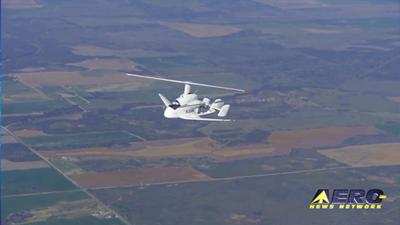Mon, May 02, 2016
Company Says Slowed Rotor/Compound Technologies Could Have Applications In The Unmanned Market
Carter Aviation Technologies, LLC (Carter) has explored interest in its Slowed Rotor/Compound (SR/C) technologies for Unmanned Aircraft Systems (UAS) in the past. Carter has formed teams and partnerships and even secured UAS study contracts with its SR/C technology, but has yet to produce a UAS demonstrator.

The same benefits of Carter’s technology that has been intriguing the manned aviation market is common with UAS applications – High efficiency enabling long range and high endurance, very quiet acoustic characteristics while loitering over an area of interest, in a simple, yet runway independent configuration, provides a compelling capability.
“We have understood the benefits of our technology for UAS missions for a long time, explained Jay Carter. “At one point in time we were selected by CENTCOM for a JCTD demonstration contract, but for a variety of reasons that project never came to fruition.” Carter is seeing increased interest in a long range, long endurance, runway independent UAS and intends to find a partner or partners with appropriate experience to pursue this business. “We recently responded to the Army’s Future Tactical Unmanned Aircraft System request for information,” stated Jay Carter. “This got our attention and as a result we have begun to rekindle past relationships as well as form new ones.”
Carter is attending the AUVSI symposium this year and among other meetings, Carter has been invited to brief the TRADOC Capability Manager for UAS regarding SR/C-based UAS concepts. “In addition to meeting with the Army, we are scheduling discussions with potential teammates,” described Jay Carter. “If the services are showing renewed interest in runway independent UAS, then this is something we cannot ignore.” Carter has had interest internationally and is currently seeking an export license for an SR/C-based UAS, but is now broadening its outreach to again include U.S. opportunities with the DoD.
Carter’s SR/C technology is scalable so it can be offered in a weight class similar to the RQ-7B Shadow UAV or provide a much larger platform with MQ-9 Reaper UAV capabilities, but without the need for launchers and recovery systems as is the case with the former or 5,000 ft plus runways in the case of the latter. Carter has developed several UAS concepts to include both jump takeoff and full hovering variants for missions ranging from cargo delivery to ISR and light strike.
(Source: Carter Aviation news release. Image from file)
More News
Aero Linx: Aviators Code Initiative (ACI) Innovative tools advancing aviation safety and offering a vision of excellence for aviators. The ACI materials are for use by aviation pra>[...]
Make Sure You NEVER Miss A New Story From Aero-News Network Do you ever feel like you never see posts from a certain person or page on Facebook or Instagram? Here’s how you c>[...]
From 2016 (YouTube Edition): Who You Gonna Call When You Have a Rocket Engine that Needs a Spacecraft? While at EAA AirVenture 2016, ANN CEO and Editor-In-Chief, Jim Campbell, sat >[...]
"In my opinion, if this isn't an excessive fine, I don't know what is... The odds are good that we're gonna be seeking review in the United States Supreme Court. So we gotta muster>[...]
Expedite Used by ATC when prompt compliance is required to avoid the development of an imminent situation. Expedite climb/descent normally indicates to a pilot that the approximate>[...]
 ANN's Daily Aero-Linx (04.30.25)
ANN's Daily Aero-Linx (04.30.25) ANN FAQ: Turn On Post Notifications
ANN FAQ: Turn On Post Notifications Classic Aero-TV: Agile Aeros Jeff Greason--Disruptive Aerospace Innovations
Classic Aero-TV: Agile Aeros Jeff Greason--Disruptive Aerospace Innovations Aero-News: Quote of the Day (04.30.25)
Aero-News: Quote of the Day (04.30.25) ANN's Daily Aero-Term (04.30.25): Expedite
ANN's Daily Aero-Term (04.30.25): Expedite



